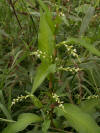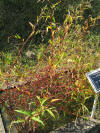WILD
FOODIES' HOME PAGE
PLANT PROFILE LIST
NAME: Pepper Smartweed
SPECIES / FAMILY: Polygonum Hydropiper / Polygonaceae
OTHER COMMON NAME(S): water pepper, marshpepper knotweed
CONDITIONS: sun/shade
|
PARTS: |
EDIBLE |
TASTE |
RAW/COOK |
SEASON |
|
All |
|
|
|
|
|
Shoots |
|
|
|
|
|
Leaves |
|
hot/peppery |
RAW/COOK |
Spring/Summer |
|
Stalk/Stem |
|
hot/peppery |
RAW/COOK |
Spring/Summer |
|
Buds |
||||
|
Flowers |
|
|
|
|
|
Fruits |
|
|
|
|
|
Pods |
|
|||
|
Seeds |
|
hot/peppery |
RAW/COOK |
Summer |
|
Nuts |
|
|
|
|
|
Roots |
|
|
|
|
|
Bark |
|
|
|
|
PORTION: small
COMMENT: I like to call it "peppergrass", as it is in the grass family. The leaves taste like hot peppers! // Leaves and stems - raw or cooked. They can also be made into an acid peppery condiment. Seed - raw or cooked. It is rather small and fiddly to utilize. The seed is used as a condiment - a pepper substitute. The sprouted seeds or young seedlings can be used as a garnish or added to salads, they are commonly sold in Japanese markets. (1)
NUTRITION/MEDICINAL: Antiinflammatory; Astringent; Carminative; Contraceptive; Diaphoretic; Diuretic; Emmenagogue; Homeopathy; Stimulant; Stomachic; Styptic.(1) The leaves contain about 7.5% protein, 1.9% fat, 8% carbohydrate, 2% ash. The leaves are said to contain rutin. (1)
CAUTION: Although no specific mention has been made for this species, there have been reports that some members of this genus can cause photosensitivity in susceptible people. Many species also contain oxalic acid (the distinctive lemony flavour of sorrel) - whilst not toxic this substance can bind up other minerals making them unavailable to the body and leading to mineral deficiency. Having said that, a number of common foods such as sorrel and rhubarb contain oxalic acid and the leaves of most members of this genus are nutritious and beneficial to eat in moderate quantities. Cooking the leaves will reduce their content of oxalic acid. People with a tendency to rheumatism, arthritis, gout, kidney stones or hyperacidity should take especial caution if including this plant in their diet since it can aggravate their condition. (1)
LOOK-A-LIKES: Lady’s Thumb (common smartweed) http://www.bio.brandeis.edu/fieldbio/medicinal_plants/pages/smartweed.html
POISONOUS LOOK-A-LIKES:
OTHER USES: Dye. A yellow-gold dye is obtained from the stalks.(1)
SOURCE LINKS (may include nutritional and medicinal info, plus other uses):

